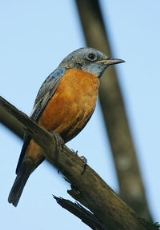
Blue-capped Rock Thrush
Encyclopedia
The Blue-capped Rock Thrush Monticola cinclorhynchus is a species of chat
. This thrush
-like Old World flycatcher
breeds in the foothills of the Himalayas
and winters in the hill forests of southern India
.
The male is bright blue and black on the upperparts with a prominent white wing mirror. The underside is rufous brown. The female is dark olive and appears barred on the underside.
Like thrushes´, they fly up into trees and tend to freeze when disturbed.
It is a summer visitor in parts of Afghanistan and along the Himalayas from Pakistan to Arunachal Pradesh. In summer it is found in pine forests and hill slopes. In winter it is found in dense canopied forests.
Chat (bird)
Chats are a group of small Old World insectivorous birds formerly classed as members of the thrush family Turdidae, but now considered Old World flycatchers....
. This thrush
Thrush (bird)
The thrushes, family Turdidae, are a group of passerine birds that occur worldwide.-Characteristics:Thrushes are plump, soft-plumaged, small to medium-sized birds, inhabiting wooded areas, and often feed on the ground or eat small fruit. The smallest thrush may be the Forest Rock-thrush, at and...
-like Old World flycatcher
Old World flycatcher
The Old World flycatcher family Muscicapidae is a large family of small passerine birds mostly restricted to the Old World. These are mainly small arboreal insectivores, many of which, as the name implies, take their prey on the wing.-Characteristics:...
breeds in the foothills of the Himalayas
Himalayas
The Himalaya Range or Himalaya Mountains Sanskrit: Devanagari: हिमालय, literally "abode of snow"), usually called the Himalayas or Himalaya for short, is a mountain range in Asia, separating the Indian subcontinent from the Tibetan Plateau...
and winters in the hill forests of southern India
India
India , officially the Republic of India , is a country in South Asia. It is the seventh-largest country by geographical area, the second-most populous country with over 1.2 billion people, and the most populous democracy in the world...
.
The male is bright blue and black on the upperparts with a prominent white wing mirror. The underside is rufous brown. The female is dark olive and appears barred on the underside.
Like thrushes´, they fly up into trees and tend to freeze when disturbed.
It is a summer visitor in parts of Afghanistan and along the Himalayas from Pakistan to Arunachal Pradesh. In summer it is found in pine forests and hill slopes. In winter it is found in dense canopied forests.

